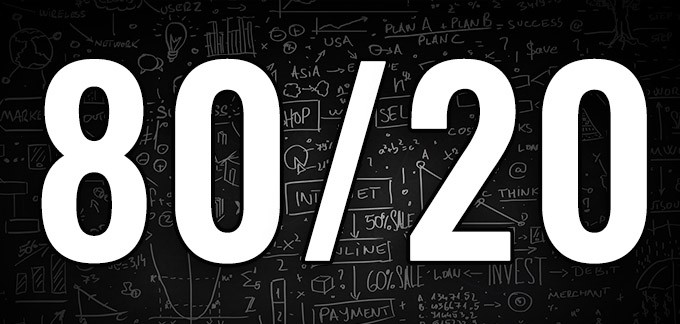When new traders enter the markets, they’re usually anxious to start trading as much as possible. Even experienced day traders will sometimes feel the urge to trade actively, regardless of the opportunities available. This feeling is natural. After all, it can be boring to stare at a screen for hours without placing any trades. That being said, when it comes to day trading, your results are based on the quality of your trades and not the quantity. It’s important to conserve energy and capital for the most profitable opportunities. This is where the 80/20 rule comes into play.
As a day trader, your goal should be to work smart and efficiently. You should always be focusing on new ways to improve your system. This requires a lot of introspection and change, but the results are well worth it. If you improve the input, you will inevitably improve the output.
The 80/20 rule states that, in many cases, 80% of the effects come from 20% of the causes. This principle was introduced by management consultant, Joseph Juran, and has since been applied in many different areas. The theory tends to have accuracy in various areas of life. For example, 80% of your stress may come from 20% of your problems, 80% of your knowledge may come from 20% of the experiences you’ve had, 80% of your happiness may come from 20% of the people in your life, etc. In trading, we want to think of it like this:
80% of your profits will come from 20% of your trades.
There are a few things you should keep in mind. First, this is a general concept and, although 80% and 20% are not arbitrary numbers, they don’t need to be exact for this theory to have a practical application. Second, this rule may not be true for everyone. Some traders may take 100% of their profits from 50% of their trades, 50% of their profits from 10% of their trades, etc. Regardless of how closely this relates to your trading results, the key takeaway is still universal:
Shift your focus to the actions that are generating the greater results
The goal is to put more time and energy into the things that make you more money. Obviously, you cannot simply trade 20% of the time you usually trade and expect to instantly improve your results. You need to pinpoint the most effective 20% of your actions and scale those up. Conversely, you need to spend less time doing the things that yield subpar results. The goal is not to do less; it’s to do more of what is making you money. Here are a few examples:
– If 80% of your profits come from short trades, but only 40% of the trades you place are shorts, you will want to increase the number of short trades you place in order to see better results. Why focus on those 60% long trades when they only account for 20% of your profits?
– If 70% of your wins come from morning trading, yet you trade all day, you may want to consider trading only in the morning.
– If 80% of your profits come from 20% of your trades, you may want to focus on the quality of the trades you place.
We’ve already mentioned the importance of keeping a trading journal and logging your activities. Looking at your trades through the “80/20 Rule” lens will help you identify your strengths and weaknesses. This will allow you to hone in on your strengths and shift your focus away from your weaknesses.
Go over your trades and look for trends. See where you make most of your money and focus your efforts there. Here are a few things you can analyze:
– # of Trades
– Type of Trades (Short/Long)
– Type of Trades (Swing Trades/Day Trades)
– Time of Day
– Day of the Week
– Indicators Used
– Rationale Behind the Trade
– Share Size Traded
– Stock Prices
– Stop Loss Levels
– Etc
As you continuously apply this strategy, your trading results should improve over time. Good luck pinpointing your strengths and weaknesses!



